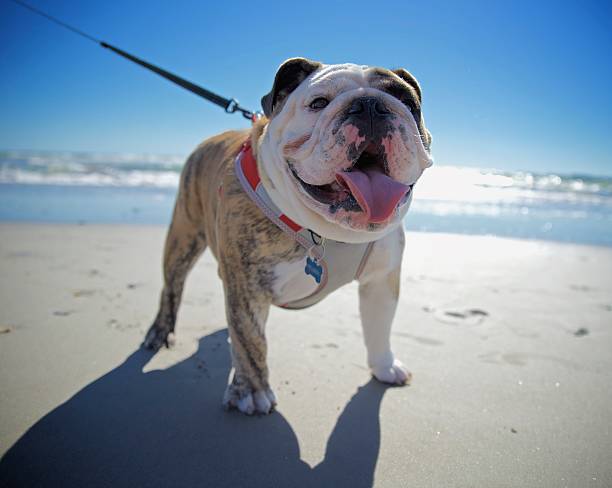The Australian Bulldog, a robust embodiment of intelligence and loyalty, has a special place in the hearts of dog lovers and families seeking a steadfast companion. With its sturdy build, playful temperament, and unmatched devotion, this breed has firmly established itself as a beloved family member and a tribute to Australian resilience.

| Category (Explanation) | Breed Information |
|---|---|
| Year of Breed Conception | 1990s |
| Country of Origin | Australia |
| Weight (Male) | 60-78 lbs (27-35 kg) |
| Weight (Female) | 50-65 lbs (23-29.5 kg) |
| Coat Type | Short, smooth |
| Color Variations | Brindle, solid red, or red with white |
| Shedding Level | Low |
| Height (cm & in) | 17-20 inches (43-51 cm) |
| Breed Size | Medium |
| Trainability | Moderate |
| Mental Needs | Moderate |
| Intelligence Level | Moderate |
| Energy Level | Moderate to high |
| Agility | Moderate |
| Loyalty | High |
| Playfulness | High |
| Exercise Needs | Regular exercise and play |
| Guarding Proficiency | Moderate |
| Sociability with Children | High |
| Barking Level | Low to moderate |
| Digging Tendency | Low to moderate |
| Destructive Behavior | Low to moderate |
| Drooling Level | Low |
| Obedience Level | Moderate |
| Apartment Friendly | Yes, with proper exercise and space |
| Inherent Prey Drive | Moderate |
| Physical Risk to Others | Low |
| Travel Fatality Risk | Low |
| Allergen Potential | Low (considered hypoallergenic) |
| Health Concerns | Hip dysplasia, respiratory issues |
| Average Life Expectancy | 10-12 years |










































































Woof Mastery is reader supported and our articles may contain affiliate links.
Instead of running third party ads that we have no control of we only use links from high-quality companies we are directly partnered with. Making use of these links come at no cost to you our reader, and in many cases have the extra benefit of discounted rates or sign up bonuses.
If you’re interested you can read more about our affiliate policy here.
We appreciate your support and always insure that the products and services we recommend are high-quality, helpful and relevant to the subject at hand!
The Australian Bulldog’s history is a tribute to the breed’s development in the vast landscapes of Australia. In the mid-20th century, breed enthusiasts in Australia embarked on a journey to create a versatile and loyal breed that could thrive in the Australian environment.
They employed a careful crossbreeding strategy, including the English Bulldog, Bullmastiff, and Boxer, to develop the Australian Bulldog. The breed was meticulously refined to exhibit loyalty, intelligence, and adaptability, making them beloved family pets and capable working dogs.
The Australian Bulldog’s journey from a mix of bulldog breeds to a recognized breed in Australia illustrates their versatility and enduring spirit, embodying the values of loyalty, intelligence, and adaptability that Australians hold dear.

What sets the Australian Bulldog apart is its versatility and intelligence. Developed in Australia, these dogs are known for their adaptability to various roles, from loyal family pets to capable working dogs. Australian Bulldogs are intelligent and eager to please, making them excellent companions and quick learners. Their unique blend of versatility and intelligence makes the Australian Bulldog truly special, embodying the values of adaptability and companionship highly prized by Australian families.
Their traditional role is that of a loyal guardian and protector, suitable for rural and farm life.
Australian Bulldogs are renowned for their friendly and outgoing personalities. They are affectionate towards their families and have a strong desire to please. Their intelligence and enthusiasm make them responsive to training, and they often exhibit a loving and dependable nature.
These dogs are characterized by their enthusiasm for life. They thrive on active play and exercise and enjoy being part of a dynamic family. Australian Bulldogs are known for their friendly and sociable nature, making them excellent companions for those seeking an energetic and affectionate pet. Their sturdy build and muscular physique reflect their active nature, but their hearts are soft and loving.
They eagerly engage in various activities with their families and are always ready to provide companionship and joy. Australian Bulldogs are the embodiment of vitality and warmth, bringing a sense of adventure to any household.
Australian Bulldogs are characterized by their loyal and protective temperament. Training and socialization are vital to manage their protective instincts effectively and maintain a well-balanced temperament. They may exhibit territorial behavior and occasional stubbornness, necessitating consistent and patient training methods. Leash training is crucial due to their strength.
When properly socialized, Australian Bulldogs tend to be friendly with other dogs and people, showcasing their well-balanced and protective nature. They are dedicated and dependable companions, known for their strong bond with their families and their readiness to protect them when needed. Australian Bulldogs are both loving and vigilant, making them excellent choices for those seeking a devoted and protective pet.
Australian Bulldogs are medium to large-sized dogs known for their muscular and well-balanced build. They possess a square-shaped head with a broad, well-defined jaw and strong cheeks, giving them a determined and confident expression.
Their eyes are typically dark and round, reflecting their alertness. Ears may be natural or cropped, depending on individual preference. These dogs feature a short, smooth coat that comes in various colors, often with white markings.
This coat not only enhances their robust and athletic physique but also complements their confident and friendly temperament. Australian Bulldogs possess a muscular neck, leading to a broad chest and sturdy, straight legs. Their tail is typically straight.
In terms of size, males typically stand between 18 to 24 inches (46-61 cm) at the shoulder, while females are slightly smaller. Weight ranges from 60 to 100 pounds (27-45 kg) for males, with females being lighter.
Overall, Australian Bulldogs project a confident and athletic presence. They have a history as versatile working and farm dogs, and their appearance exudes strength, determination, and a friendly temperament, making them an excellent choice for families seeking a loyal and hardworking companion.
Australian Bulldogs exhibit a range of color variations that enhance their athletic and agile appearance. The most common color varieties include:
Australian Bulldogs have a low to moderate shedding level. While they are not heavy shedders, some shedding may occur year-round, with increased shedding during seasonal changes. Regular grooming, including brushing with a bristle brush or a deshedding tool once or twice a week, can help manage shedding and promote coat health.
Factors that can affect shedding in Australian Bulldogs are genetics, climate, and diet. Providing adequate protection from extreme temperatures and maintaining a balanced diet can help minimize shedding. Regular grooming also plays a crucial role in managing shedding and promoting coat health.
Australian Bulldogs have short, smooth coats that are relatively low-maintenance.
Brushing: Regular brushing once or twice a week helps reduce shedding and keeps their coat in good condition.
Bathing: Bathe them as needed, but avoid over-bathing to preserve natural oils. Use a mild dog shampoo and ensure thorough rinsing and drying.
Ears: Clean their ears regularly to prevent wax buildup or infections. Use a damp cotton ball or a veterinarian-recommended ear cleaning solution.
Nails: Keep their nails trimmed to a comfortable length to prevent discomfort.
Teeth: Brush their teeth regularly to prevent dental issues and bad breath. Dental chews or toys can assist with oral care.
Wrinkle Care (if applicable): If your Australian Bulldog has wrinkles, ensure they are clean and dry between the folds to prevent skin problems. Gently clean and dry as needed.
Eye Care: Keep an eye on their eyes for signs of irritation or discharge. Clean around the eyes if necessary with a damp cloth.
Australian Bulldogs have a moderate activity level. They are known for their loyalty and versatility. Here are some key points to consider about their activity level:
Australian Bulldogs are characterized by their moderate intelligence, in harmony with their sturdy physique. Their intelligence is revealed through various facets:
Australian Bulldogs may not top the charts in problem-solving or obedience, but their intelligence, combined with their loyalty and protective instincts, makes them dependable family pets and guardians. They have a strong sense of duty to their loved ones and are always prepared to watch over and safeguard them. Proper training and socialization are essential for their well-rounded behavior.
Australian Bulldogs crave activities that engage their minds. Offering them toys that challenge their intellect, like puzzles, or involving them in obedience exercises, can keep them mentally sharp.
Social Interaction: Being sociable creatures, Australian Bulldogs require regular bonding with their family. Leaving them alone for extended periods can lead to feelings of isolation and distress.
Exercise: For Australian Bulldogs, physical activity doesn’t only cater to their physical needs; it also caters to their mental well-being. Engaging in consistent exercise helps ward off restlessness and keeps them mentally sound.
Training and Obedience: This breed benefits from training sessions which not only mentally stimulate them but also strengthen their bond with their guardians. Use positive reinforcement techniques for best results.
Routine and Structure: Like many dogs, Australian Bulldogs find comfort in a routine. Establishing a regular daily schedule helps them know what to expect and reduces feelings of uncertainty.
Affection and Attention: They thrive when they are showered with love. Devote quality time to your Australian Bulldog, recognizing their deep sense of loyalty and desire for human connection.
Socialization: It’s essential to expose Australian Bulldogs to various environments, people, and animals early on. This ensures they grow up to be well-rounded and adaptable dogs.
Safe Environment: Your home should be a haven for your Australian Bulldog. Make sure there’s a special corner or spot they can call their own, where they can wind down when needed.
Consistency: Keeping a consistent approach, be it in training or daily activities, ensures your Australian Bulldog feels secure and comprehends their surroundings better.
Enter The Woof Mastery

Before bringing an Australian Bulldog into your home, it’s vital to understand their unique needs. These dogs are known for their friendly and outgoing nature. They require regular exercise and mental stimulation to maintain their well-being. Training and socialization are essential to ensure they are well-behaved.
Be prepared for potential health concerns like hip dysplasia. Grooming needs are relatively low. Responsible ownership includes providing a loving and safe environment for these loyal and active companions.
Australian Bulldogs, bred for adaptability to Australian climates, have the potential to pose a physical danger if not properly socialized, trained, or managed. A dog’s behavior is a result of factors like temperament, upbringing, training, and owner commitment. Here’s their potential danger evaluation:
Australian Bulldogs are renowned for their friendly and outgoing personalities. They are affectionate towards their families and have a strong desire to please. Their intelligence and enthusiasm make them responsive to training, and they often exhibit a loving and dependable nature.
These dogs are characterized by their enthusiasm for life. They thrive on active play and exercise and enjoy being part of a dynamic family. Australian Bulldogs are known for their friendly and sociable nature, making them excellent companions for those seeking an energetic and affectionate pet.
Their sturdy build and muscular physique reflect their active nature, but their hearts are soft and loving. They eagerly engage in various activities with their families and are always ready to provide companionship and joy. Australian Bulldogs are the embodiment of vitality and warmth, bringing a sense of adventure to any household.
Australian Bulldogs, bred for the Australian climate and with similarities to other bulldog breeds, possess unique characteristics affecting their swimming capabilities. Here are relevant factors:
While some Australian Bulldogs might manage to swim or wade comfortably in shallow waters, always be mindful of their limitations and prioritize safety during any aquatic endeavor.
Australian Bulldogs, like their canine peers, exhibit a range of vocalizations they use as a form of expression and communication. Here’s a look into their vocal world:
For Australian Bulldog owners, it’s vital to comprehend their pet’s vocalizations and the reasons for them. While many sounds are simply part of their character, others might indicate specific needs or discomfort. Positive reinforcement techniques can prove instrumental in managing their vocal behavior.
Australian Bulldogs thrive in homes where they receive love, structure, and socialization opportunities. Here are some ideal living conditions for Australian Bulldogs:
Challenges:
When it comes to travel fatality risk for Australian Bulldogs, consider the following potential constraints specific to this breed:
By addressing these potential constraints and taking necessary precautions, you can help ensure the safe travel of your Australian Bulldog and minimize travel-related risks.
Australian Bulldogs may be prone to specific health concerns. While not all individuals will experience these issues, it’s essential for Australian bulldog owners to be aware of potential health problems and work with veterinarians to maintain their pets’ well-being. Common health concerns for this breed include:
For Australian Bulldogs, a combination of regular veterinary visits, balanced nutrition, and controlled exercise is key. Being observant and proactive in their care regimen ensures a long, healthy life.
Proper nutrition is essential for the health and well-being of Australian Bulldogs. Here are some nutritional habits and best practices to consider for this breed:
By following these nutritional best practices and working closely with your veterinarian, you can ensure that your Australian Bulldog enjoys a healthy and active life.
Breed-Specific Laws (BSL): Australian Bulldogs, a breed designed to suit the Australian climate, might sporadically face breed-specific laws (BSL) in regions unfamiliar with the breed.
Types of Restrictions: These can span spaying/neutering requirements, unique licensing, liability insurance obligations, muzzling protocols in public areas, and in rare cases, ownership bans.
Rationale for BSL: The implementation of BSL is usually rooted in concerns about certain breeds’ safety aspects. While Australian Bulldogs are adaptable and friendly, misconceptions can arise.
Controversy: The appropriateness of BSL is a matter of debate, with many suggesting that laws should target behavior over breed.
Local Regulations: Those intrigued by the Australian Bulldog should be aware of local regulations and potential restrictions related to the breed.
Woof Mastery is reader supported and our articles may contain affiliate links.
Instead of running third party ads that we have no control of we only use links from high-quality companies we are directly partnered with. Making use of these links come at no cost to you our reader, and in many cases have the extra benefit of discounted rates or sign up bonuses.
If you’re interested you can read more about our affiliate policy here.
We appreciate your support and always insure that the products and services we recommend are high-quality, helpful and relevant to the subject at hand!
Myth 1: Australian Bulldogs are Aggressive by Nature
Myth 2: They Are High-Energy Dogs
Myth 3: They Are Not Good with Children
Myth 4: They Can’t Tolerate Cold Weather
Myth 5: They Are All the Same Size
Myth 6: They are Always Clingy
Myth 7: They Don’t Require Training
Myth 8: They Shed Excessively
Myth 9: They Are Unhealthy Dogs
Myth 10: They Are Always Good with Other Dogs
The Australian Bulldog holds cultural significance in various contexts:
While there may not be as many famous Australian Bulldog owners as there are for other dog breeds, here are a few notable individuals who have been associated with Australian Bulldogs:
Australian Bulldogs, like many other dog breeds, have faced several threats and challenges over the years. Some of the significant threats and issues that have affected the breed include:
The Australian Bulldog is believed to have been developed from a combination of various breeds, with the primary ancestors being the English Bulldog and Bullmastiff. The breed’s development was influenced by Australia’s unique climate and working conditions. The specific breeds and strains that contributed to the Australian Bulldog’s development include:
Australian Bulldogs are a blend of athleticism and affection, epitomizing the spirit of companionship. Their robust physique and loving nature make them wonderful playmates for active individuals and families. These dogs thrive in various living conditions and demand only minimal grooming. Their intelligence and eagerness to please make them quick learners, excelling in various activities and training.
While they are strong and athletic, they are also gentle and patient, particularly with children. Australian Bulldogs quickly form deep bonds with their human companions, providing unwavering loyalty and devotion. Their distinctive appearance and zest for life add a unique charm to every household. These versatile dogs effortlessly transition from beloved family pets to diligent working dogs.
Above all, they offer profound and unconditional love, becoming treasured family members who enrich lives with their unwavering companionship. Embrace the extraordinary love and dedication of an Australian Bulldog and make them an integral part of your life.